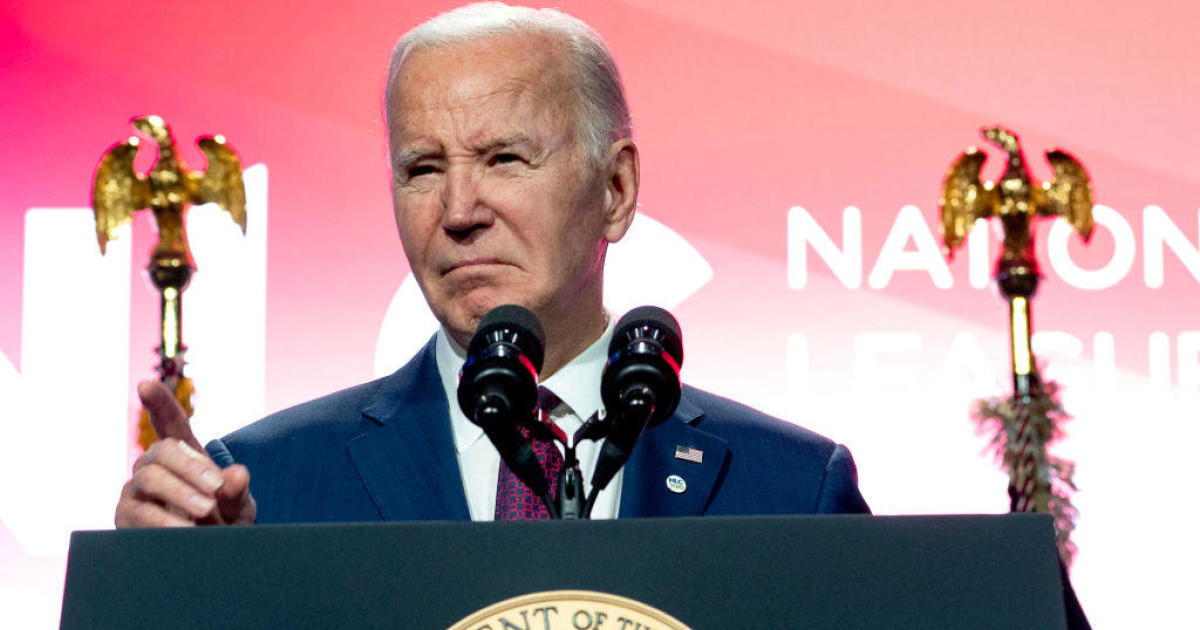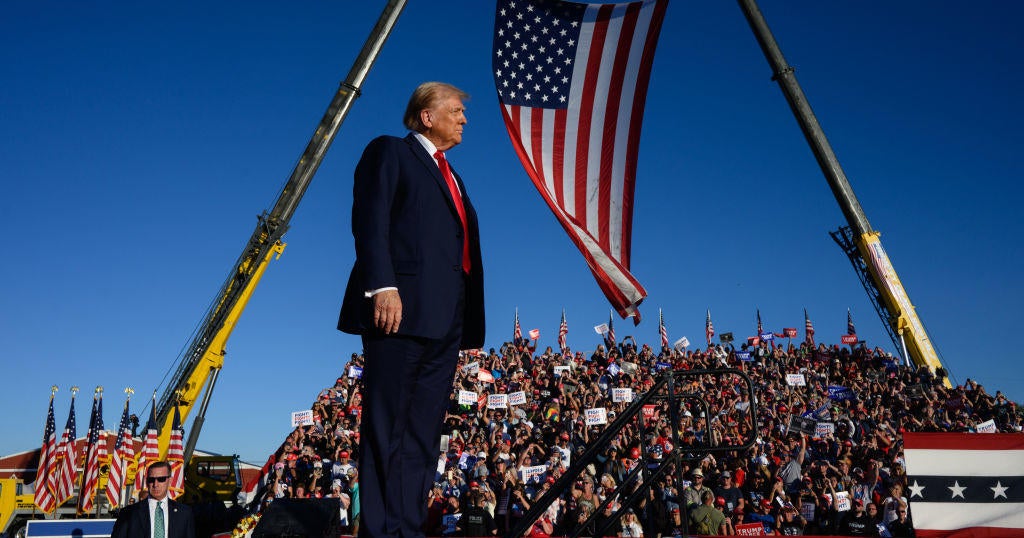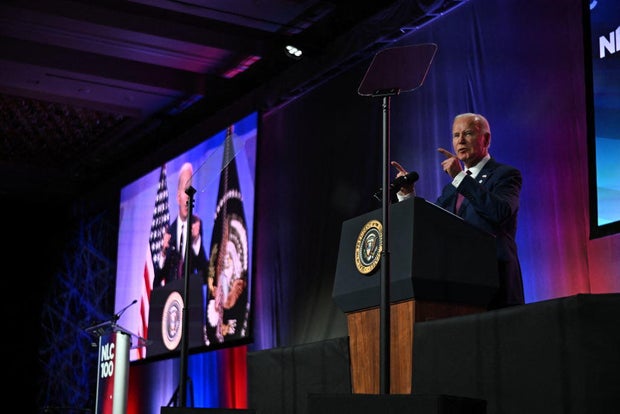CBS News
Biden releases 2025 budget proposal, laying out vision for second term

Washington — President Biden on Monday released a budget proposal aimed at getting voters’ attention: It would offer tax breaks for families, lower health care costs, smaller deficits and higher taxes on the wealthy and corporations.
Unlikely to pass the House and the Senate to become law, the proposal for fiscal 2025 is an election year blueprint about what the future could hold if Mr. Biden and enough of his fellow Democrats win in November. The president and his aides previewed parts of his budget going into last week’s State of the Union address, and they provided the fine print on Monday.
If the Biden budget became law, deficits could be pruned $3 trillion over a decade. It would raise tax revenues by a total of $4.9 trillion over that period and use roughly $1.9 trillion to fund various programs, with the rest going to deficit reduction.
Biden aides said their budget was realistic and detailed while rival measures from Republicans were not financially viable.
“Congressional Republicans don’t tell you what they cut, who they harm,” White House budget director Shalanda Young said. “The president is transparent, details every way he shows he values the America people.”
What’s in Biden’s budget
Parents could get an increased child tax credit in 2025, as payments would return briefly to the 2021 level funded by Mr. Biden’s coronavirus pandemic relief package. Homebuyers could get a tax credit worth up to $10,000 in down payment aid for first-time buyers. Corporate taxes would jump upward, while billionaires would be charged a minimum tax of 25%.
Mr. Biden said in his State of the Union that Medicare should have the ability to negotiate prices on 500 prescription drugs, which could save $200 billion over 10 years. Aides said his budget does not specify how many drug prices would be subject to negotiations.
The president is traveling Monday to Manchester, New Hampshire, where he’ll call on Congress to apply his $2,000 cap on drug costs and $35 insulin to everyone, not just people who have Medicare. He’ll also seek to make permanent some protections in the Affordable Care Act that are set to expire next year.
JIM WATSON/AFP via Getty Images
The proposal would provide about $900 billion for defense in fiscal year 2025, about $16 billion more than the baseline.
The Biden administration is still seeking money to help Ukraine defend itself against Russia and aid for Israel. His budget plan reiterates the supplemental funding request made last October for Ukraine, Israel and humanitarian relief for Palestinians.
It’s also requesting funding to expand personnel and resources at the U.S. southern border. Still, military spending over 10 years would fall by $146 billion to $9.57 trillion.
One key theme in the budget plan is an effort to help families afford their basic needs, as the impact of inflation hitting a four-decade high in 2022 continues to leave many voters feeling as though they’re worse off under Mr. Biden.
The budget proposal includes $258 billion to help build or preserve 2 million homes, helping to address a national shortage that has kept housing prices high. Parents making under $200,000 annually would have access to child care, with most eligible families paying no more than $10 a day.
It would eliminate origination fees on government student loans, possibly saving borrowers $1,000 over the life of the debt. It also includes $12 billion to help universities develop strategies for reducing their costs.
All of this is a chance for Mr. Biden to try to define the race on his preferred terms, just as the all-but-certain Republican nominee, Donald Trump, wants to rally voters around his agenda.
“A fair tax code is how we invest in things that make this country great: health care, education, defense and so much more,” Mr. Biden said at last Thursday’s State of the Union address, adding that his predecessor enacted a $2 trillion tax cut in 2017 that disproportionately benefited the top 1% of earners.
Trump, for his part, would like to increase tariffs and pump out gushers of oil. He called for a “second phase” of tax cuts as parts of his 2017 overhaul of the income tax code would expire after 2025. The Republican has also said he would slash government regulations. He has also pledged to pay down the national debt, though it’s unclear how without him detailing severe spending cuts.
“We’re going to do things that nobody thought was possible,” Trump said after his wins in last week’s Super Tuesday nomination contests.
House Republicans on Thursday voted their own budget resolution for the next fiscal year out of committee, saying it would trim deficits by $14 trillion over 10 years. But their measure would depend on rosy economic forecasts and sharp spending cuts, reducing $8.7 trillion in Medicare and Medicaid expenditures. Mr. Biden has pledged to stop any cuts to Medicare.
“The House’s budget blueprint reflects the values of hard-working Americans who know that in tough economic times, you don’t spend what you don’t have — our federal government must do the same,” House Speaker Mike Johnson of Louisiana said in a statement.
Meanwhile, Congress is still working on a budget for the current fiscal year. On Saturday, Mr. Biden signed into law a $460 billion package to avoid a shutdown of several federal agencies, but lawmakers are only about halfway through addressing spending for this fiscal year.
CBS News
Reporters’ notebook: A reflection on our return to Butler 84 days later

It was hard to miss the massive American flag towering over the Butler Farm Show ground on July 13 as it waved over the rally site where former President Donald Trump was set to speak, just days before a crucial running mate selection and the Republican National Convention.
On July 13, the two of us, who had been tag-teaming coverage of Trump’s third run for president for over a year, went to what we thought would be a typical Trump rally in an open field in a Pittsburgh suburb, a crucial electoral area in a crucial battleground state. It ended with a gunman trying to take Trump’s life, and the death of a fireman, Corey Comparatore.
We stood front and center in the press area at 6 p.m. and Trump took the stage (an hour late, as can be the case) and knew right away that something wasn’t right when what sounded like firecrackers went off to our left. That’s where shooter Thomas Crooks had climbed up onto an unprotected building just outside of the security perimeter and fired multiple shots.
A hydraulic lift that held up a massive stack of speakers was struck, sending smoke shooting out and the speakers slowly fell towards the ground, and as we took cover (ground twice), all we could think was to pull out our phones and get to work. Olivia recorded the sounds of panicked journalists and attendees alike huddled along the press riser and bicycle racks separating us, the shrieks of scared children, and, realized only upon listening many times since, the sound of those around Corey Comperatore yelling for assistance.
Jake spoke with emergency room Dr. James Sweetland, who ran to help Comperatore, and said that he heard the gunshots and went to assist, finding Comperatore “jammed between the benches” before attempting to save his life.
We both stood in shock as the crowd turned on us in the moments after Trump’s motorcade sped out of Butler, with one man yelling “This is your fault!”
What was to be a typical Trump rally wasn’t so typical anymore.
Eighty-four days later Trump returned, and so did the two of us, taking the same route from downtown Pittsburgh, parking in the same location, and enduring a similar heat with no shade in the press pen alongside fellow reporters who, just like us and the former president, chose to return and confront our trauma.
The stage was set up in the same location, with that same American flag looming over Trump and the crowd behind him on that day.
But for everything that was the same that day, there were striking differences. The building where the gunman had climbed up, crawled across, and ultimately fired fatal shots, was completely obstructed from the view of the crowd by tractor trailers. Several teams of snipers were stationed throughout the rally site. It was perhaps the largest crowd we have seen thus far at a Trump rally.
And we are not the same people. Witnessing the events of July 13 took away our feeling of safety while doing our jobs, and the effects of that continue to impact us. There was a moment of shock at one point, when the speaker on stage paused as the crowd shouted “medic” for a woman who fainted. We were frozen in fear hearing the same words that were shouted in the seconds after Trump’s assassination attempt, as people were shouting for a medic to take care of Comperatore.
But like July 13, we had to go to work. Like those in the crowd of tens of thousands that chose to return, there was a sense of unfinished business on this fairground. We had continued on to Milwaukeee and the Republican National Convention to cover Trump’s first public appearance since Butler, but we knew that we had to come back here, no matter how painful it was to land back in Pittsburgh, head north on Route 79 and pull off at the Butler Farm Show, and finish the job: for the two of us, for CBS News, for the country.
Unlike other speakers on the stage Saturday who championed Trump’s words of “fight, fight, fight,” Sweetland went out of his way to mention he is a former Democrat and pleaded with the crowd to reach out and find five Democrats with whom they could find commonality.
“Democrats are like teenagers,” Sweetland said. “You think they aren’t listening, but they are.”
Eight-four days later, the entire race has changed, and so have we.
CBS News
Jewish communities on high alert ahead of one-year mark of Oct. 7

Watch CBS News
Be the first to know
Get browser notifications for breaking news, live events, and exclusive reporting.
CBS News
Recalling the Oct. 7 massacre nearly one year on

Watch CBS News
Be the first to know
Get browser notifications for breaking news, live events, and exclusive reporting.









